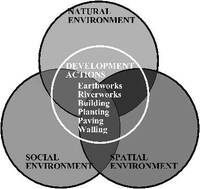- England
- Scotland
- France
- Holland
- Germany
- Italy
- Spain
- Portugal
- USA
- China
- Japan
- India
- Iran
- Advice
- Gardens
- England
- Scotland
- France
- Holland
- Germany
- Italy
- Spain
- Portugal
- USA
- China
- Japan
- India
- Iran
- Advice
- Garden Tours
Book: Landscape Planning and Environmental Impact Design: from EIA to EID
Chapter: Chapter 3 Context sensitive design theory
Control by EA fails when it is too pragmatic. When it became apparent that the zoning system was not creating or protecting zones of environmental quality, it was supplemented by a second approach. Basically, the new idea was to assess each project as it arrived on the development agenda and discover what impact it would have on its surroundings. This became known as Environmental Assessment (EA) or Environmental Impact Assessment (EIA). The idea originated in America , partly because of its extra-rigid system of zoning. Planning control in some American states was much less comprehensive than in Europe and there was great public concern about the harmful effect which individual development projects were having on the environment. The National Environmental Policy Act (NEPA) of 1969 became a model for similar legislation throughout the world. The key NEPA provision was that an Environmental Impact Statement (EIS) must be prepared for 'all major Federal actions significantly affecting the quality of the human environment'. The word 'actions' included building a house, planting a forest, felling a forest, laying a pipeline or carrying out a military exercise. The great value of the EA approach was that it included every influence of every project on every aspect of its context. [Fig 3.7] Environmental assessment should, in theory, extend to every influence of every project on every aspect of its environmnetal context. Interaction matrixes were produced [Fig 3.8]. Land users were prompted to consider the affects of each aspect of a development upon each component of the natural, social and spatial environment. For example, 'Soldiers defecating' was included for an EA of a military exercise in a wilderness area. For a road-building project, the component actions would include construction of a site office , removing vegetation, hiring local labour, stripping topsoil, deflowering local virgins, excavating subsoil, laying a base course, adjusting drainage patterns, and so on for ever. It was and r ema ins a bonanza for environmental lawyers and scientists. A distinction can be drawn between: -Strategic Environmental Assessment, which is concerned with the assessment of general policies, plans and programmes -Environmental Impact Assessment, which is carried out by organisations proposing specific development projects. The Florida Power and Light Company, in preparing EIA's for new power stations, had to submit 5mm (3") thick report in 1970, a 75mm (3") report in 1971, a 150mm (6") report in 1973 and a 600mm (24") report in 1977. To deal with this escalation, restrictions were placed on the total length of American Environmental Impact Statements and on the categories of project for which they were required. The scope of the European Community directive on EIA was restricted to medium scale projects. Small-scale buildings and large-scale forestry or agriculture were excluded. The Australian's proposal could fall within Schedule 2 Section 10 of the European Community directive, as a significant urban development project. Scientists could then identify negative impacts on fauna and flora. The hillside church would have an extensive Zone of Visual Influence. The cultural landscape would be adversely affected. It is likely that the project would not be approved. Control by EIA has an anti-development bias. The inbuilt assumption is that the status quo ought not to change.
